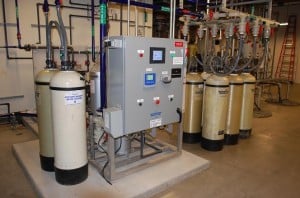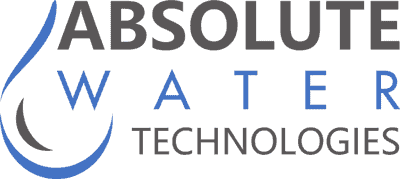Proper Application of (SDI / DI) Deionization Tank Exchange Service
Proper Application of Service Deionization (SDI) (DI) Tanks and Placement in a High Purity Water Treatment System-
 Commonly referred to as Service Deionization Tanks or SDI / DI tanks, these portable deionization columns / tanks can be used in a variety of cost effective ways for end users in process water and high purity water treatment applications. Application of the system is key, and can often be misapplied and potentially counter-productive or even hazardous when put in the hands of an inexperienced water treatment supplier.
Commonly referred to as Service Deionization Tanks or SDI / DI tanks, these portable deionization columns / tanks can be used in a variety of cost effective ways for end users in process water and high purity water treatment applications. Application of the system is key, and can often be misapplied and potentially counter-productive or even hazardous when put in the hands of an inexperienced water treatment supplier.
How It Works
Deionization is used to produce theoretically pure water from a natural water source. When minerals and salts are dissolved, they break down into charged ions, many of which are considered impurities. Many of these impurities can be removed through deionization. Depending on your areas feed water source, these conductive materials can range from under 100 to well over 1000 Microsiemens (m/s) of conductivity. Service deionization tanks, depending on how applied, can exchange/replace these contaminants that can interfere with a variety of applications.
The mechanism for removing ions from water using charged resins is known as ion replacement, also called demineralization or ion exchange. Via the exchange process, ions of a given charge are replaced with different ions of a like charge that are more compatible with an application. Positively charged ions are replaced with hydrogen (H+) ions and negatively charged ions are replaced with hydroxide (OH-) ions which are components of pure water. Positively charged ion resin is called cation, whereas, negatively charged ion resin is called anion.
Separate Bed versus Mixed Bed SDI / DI Tanks
Separate or Single Bed
When feed water is filtered through a tank that contains cation resin, and then passed through a tank that contains anion resin, the technique is labeled single bed exchange. Separate bed exchange produces water with a resistivity of up to potentially 1 megohm-cm. The tank containing the cation resin should always be positioned before the tank containing the anion resin. This ensures that the calcium and magnesium in the feed water will be removed before it reaches the anion resin, thus preventing fouling of the anion resin. This set up is common when a reverse osmosis machine is not cost effective due to the limited water use or when removal of other minerals and chemicals such as fluoride, lead and microorganisms are not a significant factor.
Mixed Bed- High Purity Applications
When feed water is passed through a tank that contains a combination of cation and anion resins, the process is called mixed bed (dual bed) exchange. Generally, a mixed bed tank contains 40% cation resin and 60% anion resin. Mixed bed systems produce very high quality water with a resistivity of up to 18.3 megohm’s temperature compensated at 25° C. Mixed bed systems remove more contaminants, and provide a more neutral pH than do single bed systems. In some cases it is cost effective to incorporate separate cation and anion beds before mixed beds to remove the bulk of the dissolved ions from the feed water in water systems with high initial conductivity in instances where a Reverse Osmosis (RO) System is not part of the system. For high purity applications, a second mixed bed should be used as a final polishing step to achieve a higher final water quality. In this configuration, the first tank is called the worker and the second tank is called the polisher. Since resin beds exhaust or deplete overtime, pretreating the ion exchange system with reverse osmosis (RO) followed by electro-deionization (EDI) can lower the operating cost of deionization. In a number of instances in high purity applications an RO (Reverse Osmosis) machine may be required to remove other microorganisms and impurities not removed by the deionization tank systems.
Specialty Tanks
Other than standard resin tanks there are many resin tank applications that can be used. Organic scavenger anion tanks for example are helpful in areas with a large amount of organics. Softening tanks and colloidal removal tanks are also available from some suppliers.
Polishing SDI/DI Tank Placement in a High Purity / Ultra-Pure Water Treatment System:
If there is a concern in your application for TOC, a 185 NM (nanometer) UV light should be placed prior to the mixed bed tanks. To eliminate any potential for bacteria being entered in to the system through the SDI/DI tanks a 254NM (nanometer) UV light should be incorporated followed by a submicron filter to remove pyrogens. It is also a best practice, when possible, to recirculate water through the deionization tanks, UV’s and final filtration on a continual basis to achieve the highest quality of water and to ensure proper water flow discourages bacterial growth and biofilm. For more advice on design of a high purity water system please see ….. Avoiding Design Pitfalls of a High Purity Water Treatment System.
Figuring Flow Rates
It is critical to make sure flow rates of a system are measured properly to ensure the correct sizing of portable service deionization tanks are used. Tanks are available in a variety of sizes and should be reviewed with a reputable supplier. Improper flow rates can turn into several problems such as potential for resin channeling, poor quality, premature exhaustion of the deionization tanks etc.
Special Handling of Tanks:
Prior to being placed in service many regulatory agencies and internal QSR’s require that the quality be proven before placing the tank on line. There are reasons that your supplier should flush the tanks to ensure proper quality measurements are met and any potential bacteria is flushed out on a validated flush stand prior to placing the tanks in service. Carbon tanks that precede the sdi/di tanks should also be flushed. A best practice is to insist on virgin carbon for better chlorine removal and higher purity.
For responsive service and delivery of SDI/DI Tanks in the Indianapolis Indiana area and surrounding areas by the High Purity Water Treatment specialists, contact Absolute Water Technologies today at 1-866-986-6860 or email us at info@absolutewatertechologies.com

